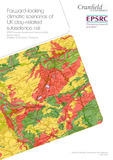JavaScript is disabled for your browser. Some features of this site may not work without it.
| dc.contributor.author | Hallett, Stephen H. | |
| dc.contributor.author | Farewell, Timothy | |
| dc.contributor.author | Pritchard, Oliver G. | |
| dc.date.accessioned | 2017-08-24T15:08:42Z | |
| dc.date.available | 2017-08-24T15:08:42Z | |
| dc.date.issued | 2015-06-01 | |
| dc.identifier.citation | Hallett, S.H., Pritchard, O.G and Farewell, T.S. (2015) Forward-looking climatic scenarios of UK clay-related subsidence risk. 37pp. CSAFI Report, Cranfield University, UK. | en_UK |
| dc.identifier.uri | http://dspace.lib.cranfield.ac.uk/handle/1826/12378 | |
| dc.description.abstract | An award drawing upon the Cranfield University EPSRC-funded Impact Acceleration Account (IAA) was awarded to staff in the University’s School of Energy, Environment and Agrifood (SEEA) (Hallett, Farewell, Pritchard), to undertake processing of UKCP09 climate projections for the United Kingdom (UK) in support of assessments of future geohazards and societal impact. This report identifies the technical outcomes from this work and presents the resultant climate change cartography and related data. Spatially coherent national data ensembles are generated for the UKCP09 ‘Baseline’ period, for ‘2030’ and ‘2050’. Maps of Potential Soil Moisture Deficit (PSMD) are produced for each to exemplify its application. The findings suggest that the extremes in PSMD observed at the current time in the UK are likely to become the norm by 2030 and 2050. The data produced has a range of potential applications, from geohazard assessments to the built environment and infrastructure, to agri-informatic modelling of agricultural crops, as well as modelling for 'future-proofing' of buildings against predicted climate change by example. It is anticipated that the datasets presented from this IAA will be of benefit to a range of end-user stakeholders. One example is in the insurance, reinsurance and water utility sectors, where modelling of future impacts of climate change are conducted. Recent research has suggested this data will likely prove of use for County Councils and municipal authorities, for example in the allocation of targeted road maintenance funding, particularly on local-authority owned highways. Rail network operators, having faced a number of embankment failures, and track undulations as a result of shrink/swell activity are also likely to benefit from this research. The soil moisture deficit scenarios produced could help such organisations better manage geotechnical assets and vegetation management of susceptible slopes and soils. Cranfield’s School of Energy, Environment and Agrifood (SEEA) manage and operate the Natural Perils Directory (NPD). The NPD is a widely used geohazard thematic dataset portraying vulnerabilities arising from soil-climate responses to long-term climate change. NPD will incorporate directly the datasets produced and described here. | en_UK |
| dc.language.iso | en | en_UK |
| dc.publisher | Cranfield University | en_UK |
| dc.relation.ispartofseries | Cranfield University EPSRC-funded Impact Acceleration Account (EP/K503927/1) | en_UK |
| dc.subject | Soils | en_UK |
| dc.subject | Climate Change | en_UK |
| dc.subject | Geohazards | en_UK |
| dc.subject | UKCP09 | en_UK |
| dc.title | Forward-looking climatic scenarios of UK clay-related subsidence risk | en_UK |
| dc.type | Report | en_UK |
Files in this item
This item appears in the following Collection(s)
-
Staff publications (SWEE) [2825]
